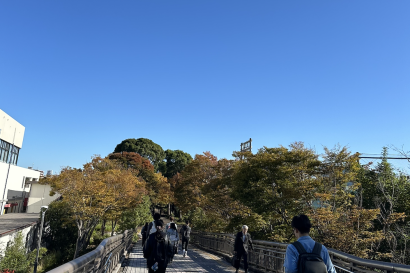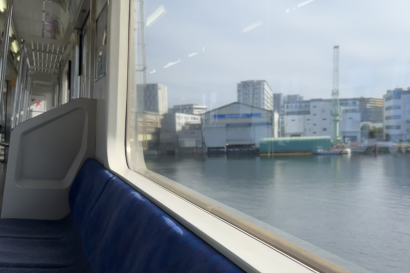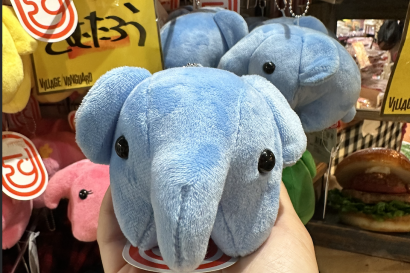The IES trip to Okinawa was four days and three nights packed with amazing activities and good food, and I could write volumes about everything we did on there. To spare you the long-winded explanation, I’ll summarize most of what we did and write more extensively on one or two things from each day.
But first, some context–Okinawa could be called Japan’s Hawaii. When people in Japan hear the name “Okinawa” they most likely think of sunshine, sparkling beaches, hawaiian shirts, pork-based cuisine, and Okinawan sweet potatoes. For a long time Okinawa was its own island kingdom called Ryukyu, and it developed a flourishing, peaceful culture through exchange with China and southern Japan. It was made a prefecture of Japan in 1879, and some Okinawans are still a little resentful of Japanese control. Okinawans speak Japanese with a dialect that is difficult even for native Japanese speakers to understand.
The day we arrived, the first place we visited was Shuri castle. This castle housed the royal family of the Ryukyu Kingdom from the 15th century, and its architecture shows heavy Chinese influence. In the Meiji period, when Okinawa became a prefecture of Japan, Shuri castle was used as military headquarters and school buildings. The castle was completely destroyed in 1945, but was restored some time later. Shuri castle had many gates and courtyards; it was clear that this castle had been much more than just a royal dwelling. In its day it had also been used as a religious and artistic center. When we visited, there were many people working there who dressed in traditional Okinawan clothing, and even some performing traditional dances. Even though the weather was questionable, the rain held off long enough for us to explore the grounds.
After leaving Shuri castle we traveled to the community center in the town of Onna, where a couple of friendly guys in hawaiian shirts taught us how to play the Sanshin. The Sanshin is a banjo-like instrument that is central to traditional Ryukyu culture–in courtship, for example, the man would play the Sanshin while the woman danced. Our teachers told us that many boys in Okinawa today can play the Sanshin at least a little bit. We all learned a song together and played it as one big Sanshin orchestra. I found the Sanshin an easy instrument to take up once you figure out the scale of its three strings–but then again, playing violin in high school probably helped with that somewhat.
The second day it rained a lot, like a lot a lot–Okinawa was just entering its rainy season, and the rain came down in thundering sheets. We visited the Peace Memorial Museum (probably not the best place to go first thing in the morning–it left everyone in a sort of sour mood) and had lunch at Okinawa World, a popular tourist spot. After that we went to the Ryukyu Glass village, where we had the opportunity to blow our own glass. That was kind of cool, but I was nervous the whole time; they warned us not to inhale while we blew the glass because if we did, we would swallow molten glass. Lovely.
The third day was my favorite of the four days. First we visited Manzamou Cliff, a scenic seaside cliff which was traditionally a place for couples to go. It was unfortunately very windy, so most of us wanted to leave as soon as possible, but it was still very beautiful. Many local vendors had lined up at the entrance to the cliff to sell all kinds of tourist tchotchkies. Some of them were happy barter prices, or throw in extra little presents because we’d come from so far away.
After eating lunch in a traditional Okinawan village, we bussed over to one of Okinawa’s most well-known attractions: the Churaumi Aquarium, home of the world’s second-largest aquarium tank. The aquarium was huge and filled with all kinds of fish I’d never seen before. There were fish that looked like shoelaces, and lobster-like animals with odd faces. But the most amazing thing that the aquarium had to offer was its huge tank–and in that tank lived three whale sharks.
Admittedly, it wasn’t the greatest aquarium in terms of being animal-friendly. The big water tank was largely devoid of rocks and plants, and it was stuffed with schools of fish, dozens of rays and smaller sharks in addition to its three whale-sized tenants. The manatee exhibit, however, was even more saddening: the manatees lived two to a pool, but the pools were more like swimming pools than actual exhibits. There was no sand on the bottom, nor decorative rocks or grass. The poor manatees looked miserable. A friend and I decided to spend quite a bit of money at the gift shop in the hopes that the aquarium would eventually be able to create better habitats for some of its inhabitants.
The fish all swam too quickly for me to get good pictures, so I took some video at the aquarium and made a short compilation film, which can be viewed on vimeo here.
After the aquarium, we bussed over to Meio University. There we met up with the Eisa club, which does traditional Okinawan dance. Although I was nervous at first, our time with the Eisa club turned out to be my favorite out of all the things we did.
First, the Eisa club showed us a demonstration of their dance. An older man, possibly a teacher, plucked away at a sanshin and sang as a large group of students danced. The men (and some women) beat drums of varying sizes and jumped and threw out their feet. A row of women in pink robes behind them danced daintily to the beat of the drums. Following the demonstration, we were divided into three groups. Three or four boys were given large drums, ten people were given small drums, and the rest were to be backup dancers. I was in the small drum group. We all stood in a circle and watched as the Eisa club members showed us what to do, then we practiced all together. My coordination isn’t the best, but I got the hang of the rhythm and at least managed to keep up. The more we worked together, the wider everyone’s smiles got.
Finally, we all formed an enormous circle around the gym. We used what we’d learned to dance and play together, and after each round of the song, the tempo got faster and faster. There wasn’t a single person in the room who wasn’t smiling.
We finished the song and gave back the drums, but the Eisa club wanted to do one last dance with us. They taught us the two different dance styles for women and men, and the man on the sanshin started plucking again. All of us moved around the gym as we danced, arms waving like the tendrils of a sea anemone. Some people started dancing more wildly, improvising, laughing, clapping. No one needed to say anything. Forget language barriers–in that room, in that moment, all of us were having fun.
After the dances ended, we got together for a final group picture, and the Eisa club wanted to take many more pictures with us. Some dove into others’ pictures or scrambled around in the back, posing with fingers in a v. I unfortunately didn’t get any pictures of (or with) the Eisa club–my camera was out of reach–but maybe it doesn’t matter. What does matter is that we had a lot more fun than I’d expected to have, and I doubt I’ll be able to forget it.
The Eisa club walked us out to the bus, and waved and smiled even as we were driving away.
That night we had delicious do-it-yourself grilled meat at one of the hotel restaurants. I stuffed myself with beef and fish and didn’t think I’d be able to move the next morning.
On the last day, we went shopping at Kokusai street, which is where I got most of my souvenirs. Although most of the shops sold the exact same tourist tchotchkies, there was also an Animate (which of course I had to inspect, for… comparison purposes. yeah). We shopped for two hours or so before meeting up at Sam’s Sailor Inn, which was a Benihana-style steak restaurant. After stuffing ourselves with beef again, we left for Naha airport. At the airport I finally tried Okinawan sweet potato soft serve ice cream–and it was delicious.
There are a few things you notice when you travel around Okinawa. For one, everywhere we went, we saw Shiisa guarding the gates of houses, apartments, and shops. Shiisa are wards that keep out bad spirits, and have become the symbol of Okinawa. Everyone has a pair of of them–if not more than one. They stand dutifully near bridges, parks, and museums. Smiling Shiisa appear on restaurant signs and snack wrappers. You’d be hard-pressed to visit Okinawa without seeing at least one–in fact, there are a pair of huge Shiisa supervising the baggage claim in the airport!
Shiisa usually come in pairs: the left Shiisa has its mouth closed to keep in the good, and the right Shiisa has its mouth open to scare away the bad. Genders have also been assigned to the Shiisa, but this is a recent development and it’s widely debated which one is which. Some say the closed-mouth Shiisa is female because women should be quiet; others say the open-mouthed Shiisa is female so she can welcome in good fortune. Again, it’s a hot debate. Tourist shops everywhere sell pairs of Shiisa of varying designs, sizes, and colors; I bought a pair on the last day that can be seen below.
Another thing I noticed were these small concrete houses that had been built into hillsides. They came in different varieties; some with turtle-shell structures, others that could stand by themselves without the support of a hill. Sometimes we drove by entire neighborhoods of these houses. Our tour guide explained that the tiny houses were tombs for families’ ancestors. Okinawans believe that their ancestors live in these tombs as a second house, and they worship their ancestors as gods. At the Peace Museum I learned that during WWII, the tombs were also used as shelters for those caught in the crossfire during the Battle of Okinawa. While at first I’d thought they were kinda cool, after the museum I couldn’t look at them without getting chills down my spine.
In sum, Okinawa is an incredibly cool place to visit. There was probably tons more stuff to do there that we didn’t get around to. If you’ve got the money to go there, I really recommend it–though you should probably plan your trip at a time when Okinawa isn’t just starting its rainy season.






















Lauren Fellows
<p><span style="color: rgb(29, 29, 29); font-family: Arial, Verdana, sans-serif; font-size: 12px; line-height: normal; background-color: rgb(237, 237, 237);">Lauren Fellows is a Japanese major, geology minor studying at the University of Puget Sound in Tacoma, WA. She hails from Boulder, Colorado, and is glad to be going to school in a place with both mountains and a water feature (the weather, however, leaves something to be desired). Lauren is a huge dork who loves drawing, watching anime, writing stories, and taking pictures of toys when she isn’t spending long hours training to beat the Elite Four in the latest Pokémon game. She’s ventured to a few places outside the United States, most notably France and Israel, but this is her first time in Japan and she is SUPER EXCITED. While in Japan she plans to make friends from near and far, experience anime culture in its natural habitat, and explore an urban jungle unlike anywhere she's ever been before. The adventure of a lifetime is just over the horizon!</span></p>






